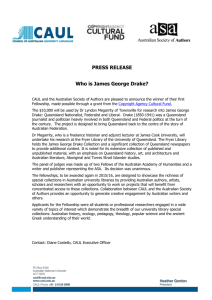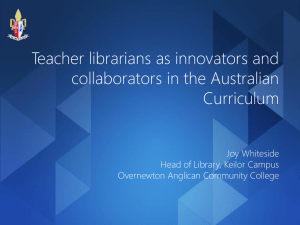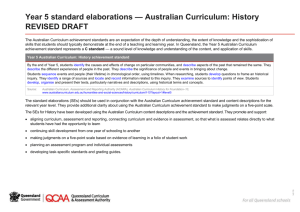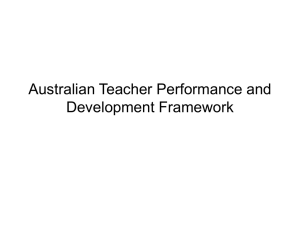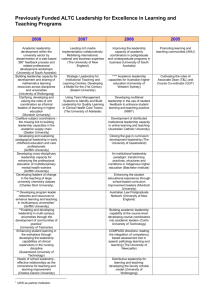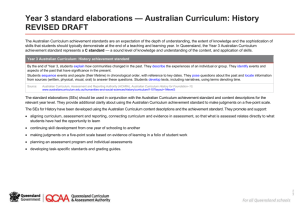Year X unit overview — Australian Curriculum: English
advertisement
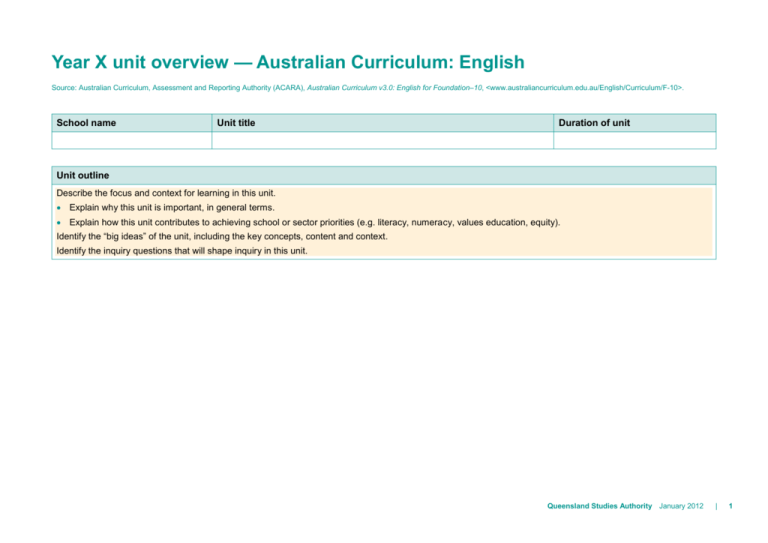
Year X unit overview — Australian Curriculum: English Source: Australian Curriculum, Assessment and Reporting Authority (ACARA), Australian Curriculum v3.0: English for Foundation–10, <www.australiancurriculum.edu.au/English/Curriculum/F-10>. School name Unit title Duration of unit Unit outline Describe the focus and context for learning in this unit. Explain why this unit is important, in general terms. Explain how this unit contributes to achieving school or sector priorities (e.g. literacy, numeracy, values education, equity). Identify the “big ideas” of the unit, including the key concepts, content and context. Identify the inquiry questions that will shape inquiry in this unit. Queensland Studies Authority January 2012 | 1 Identify curriculum Content descriptions to be taught Language Literature Literacy General capabilities and cross-curriculum priorities Insert the specific content descriptions from the Australian Curriculum that will be covered in this unit. Insert the specific content descriptions from the Australian Curriculum that will be covered in this unit. Insert the specific content descriptions from the Australian Curriculum that will be covered in this unit. Identify and describe the general capabilities and cross-curriculum priorities that will be targeted in the unit. Include any unit-specific elaborations. Include any unit-specific elaborations. Include any unit-specific elaborations. Delete those that don’t apply. Literacy Numeracy ICT capability Critical and creative thinking Ethical behaviour Personal and social capability Intercultural understanding Aboriginal and Torres Strait Islander histories and cultures Asia and Australia’s engagement with Asia 2 | Year X unit overview Australian Curriculum: English Identify curriculum Sustainability Achievement standard Insert the achievement standard for the learning area and year level from the Australian Curriculum. Queensland Studies Authority January 2012 | 3 Relevant prior curriculum Curriculum working towards Outline relevant previous curriculum content and standards (knowledge, skills and processes) that students need to succeed in this unit. Outline curriculum content (knowledge, skills and processes) that students are working towards. Specify where this content occurs by identifying the curriculum document, year level and learning area. Specify where this content occurs by identifying the year level and learning area. Bridging content Identify bridging content (knowledge, skills and processes) needed to address gaps in student understandings. Links to other learning areas Explain how this unit links to other learning areas. 4 | Year X unit overview Australian Curriculum: English Assessment Make judgments Describe the assessment Assessment date Identify the evidence of learning that will be gathered during this unit (both formative and summative). Specify when assessment will occur. Identify what type of assessment will be used, e.g. teacher observations, projects, performances, written, oral or multimodal tasks, exhibitions, self and peer assessment. Explain how the assessment is designed to cater for the varied needs and abilities of all students. Specify where feedback strategies occur to allow students to evaluate their own work and identify ways to improve it. Identify content descriptions that are the focus of student learning within assessment in this unit. List task-specific descriptors of quality. These include statements of desirable features in student work. For further advice and guidelines on constructing guides to making judgments refer to the Learning area standard descriptors: www.qsa.qld.edu.au Identify risk assessment strategies. Concisely describe the purposes of the assessment. State the conditions of the assessment, including the: format length scope resources required. Queensland Studies Authority January 2012 | 5 Teaching and learning Supportive learning environment Teaching strategies and learning experiences Adjustments for needs of learners Resources Outline key learning experiences and teaching strategies that will: Section 6 of the Disability Standards for Education (The Standards for Curriculum Development, Accreditation and Delivery) state that education providers, including class teachers, must take reasonable steps to ensure a course/program is designed to allow any student to participate and experience success in learning. List the key people, resources and relationships needed to ensure the successful delivery of all key learning experiences and assessment. ensure the identified curriculum is explicitly taught prepare students for the assessment. Identify where proficiencies are being targeted. The Disability Standards for Education 2005 (Cwlth) is available from: <www.ag.gov.au> select Human rights and anti-discrimination > Disability standards for education. Explain the specific considerations that will be given to support individual learning and assessment. Explain adjustments that will be made to the learning experiences to cater for the varied needs, abilities, interests and experiences of students. 6 | Year X unit overview Australian Curriculum: English Identify risk assessment strategies. Use feedback Ways to monitor learning and assessment Teachers meet to collaboratively plan the teaching, learning and assessment to meet the needs of all learners in each unit. Feedback to students Teachers strategically plan opportunities and ways to provide ongoing feedback (both written and informal) and encouragement to children/students on their strengths and areas for improvement. Teachers create opportunities for discussion about levels of achievement to develop shared understandings; co-mark or cross mark at key points to ensure consistency of judgments; and participate in moderating samples of student work at school or cluster level to reach consensus and consistency. Children/Students reflect on and discuss with their teachers or peers what they can do well and what they need to improve. Teachers reflect on and review learning opportunities to incorporate specific learning experiences and provide multiple opportunities for children to experience, practise and improve. Reflection on the unit plan Identify what worked well during and at the end of the unit, including: activities that worked well and why activities that could be improved and how assessment that worked well and why assessment that could be improved and how common student misconceptions that need, or needed, to be clarified. Queensland Studies Authority January 2012 | 7


